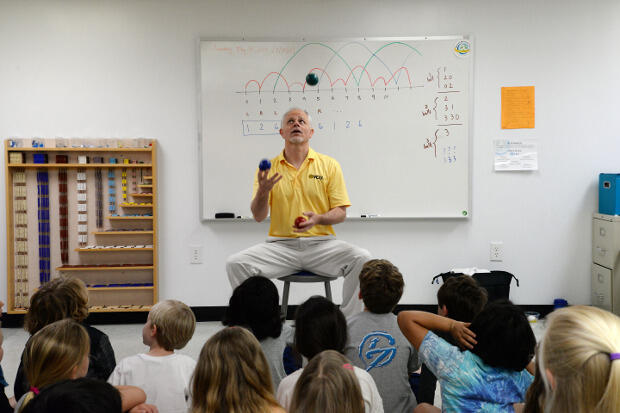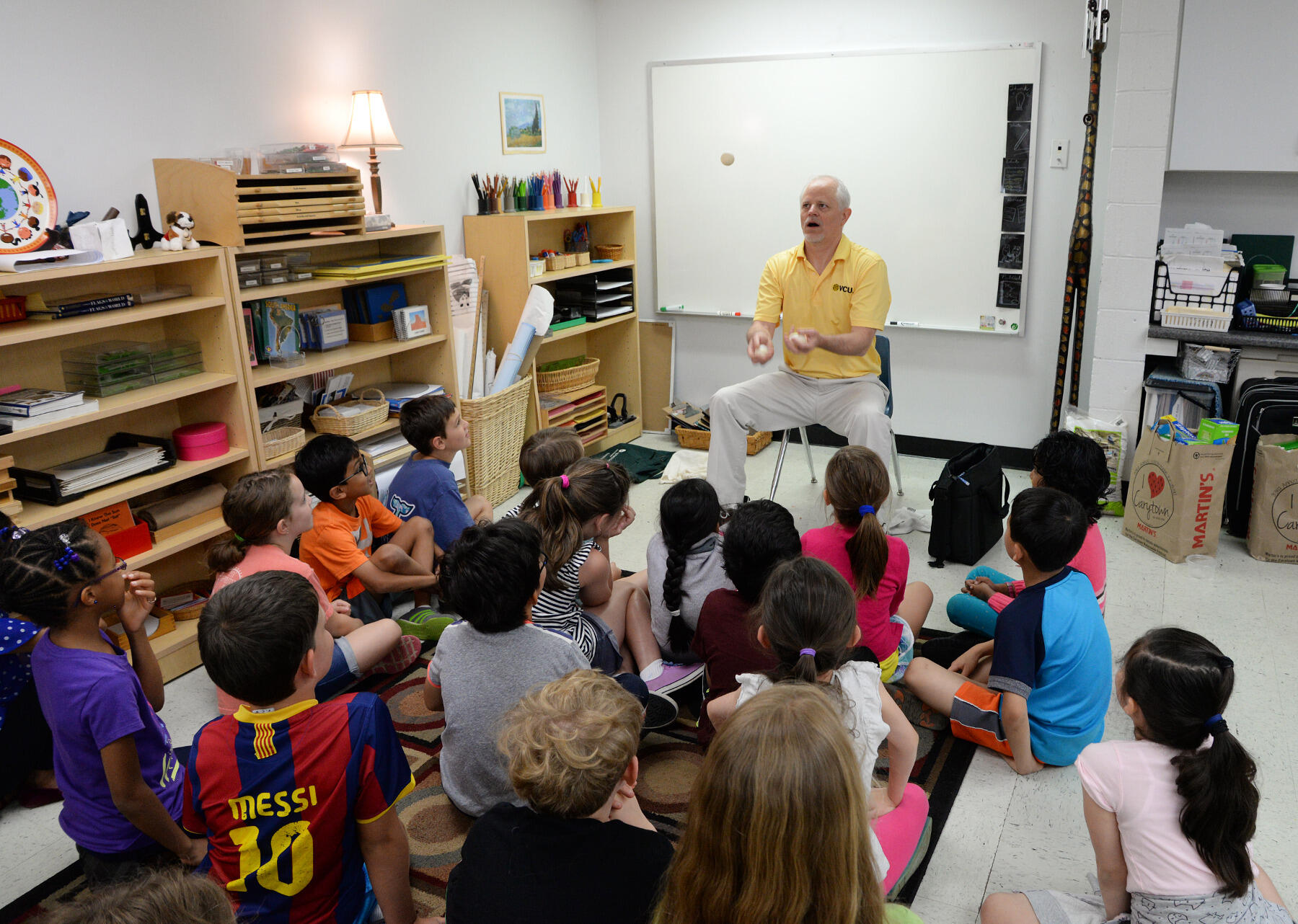
<photos by Brian McNeill, University Public Affairs
June 20, 2017
Through juggling and card tricks, VCU math chair reveals the hidden world of math to Richmond elementary, middle school students
Share this story
Before a crowd of early elementary students at Richmond Montessori School, Glenn Hurlbert, chair of Virginia Commonwealth University’s Department of Mathematics and Applied Mathematics, is juggling red, green and blue balls in increasingly complex sequences.
“Look at this,” he says. “The red ball starts in the left hand, ends in the left hand, stays in the left hand. It’s always an even number. Four, then a two, then a four, then another two. The odd numbers cross hands. Here’s an example, green goes at three because it starts left, then — because it’s odd — goes right, left, right. It changes hands.”
Each of Hurlbert’s throws and catches is plotted on a diagram behind him, illustrating how hidden mathematical sequences underlie the act of juggling.
“It’s a lot of fun to juggle, but you actually see that there’s a lot of math in juggling,” he says. “Who would have thought of that?”
Hurlbert, a professor in the College of Humanities and Sciences, has been bringing what he calls “Crazy Math Days” to his children’s schools for years, giving students from early elementary through middle school new insights into how math can not only be found in unexpected places, but can also be fun and entertaining.
Math is all over the place and used in ways that they can’t imagine.
“As a parent, I’ve always been interested in going in and helping in my kids’ classrooms, especially in an area in which teachers often struggle all over America,” he said. “Math teachers need lots of support in their ability to both communicate mathematics in an interesting way and also communicate it with a sense of the huge variety of things in the world that math can be applied to. That’s always been my motivation for getting into classrooms and schools to give them a sense that math is all over the place and used in ways that they can’t imagine.”
In addition to demonstrating the math of juggling, Hurlbert’s Crazy Math Days have featured magic tricks, including teaching young students how to perform math-based card tricks.
“I teach them a card trick they can show to their parents,” he said. “They get home and they have something they can show their parents using mathematics and it befuddles [their parents].”
Another activity involves laying down paper plates in the school parking lot, and connecting the plates with different colored masking tape that forms a maze. The students are each assigned a number, and begin to navigate the maze. At each plate, they stop and wait until another person arrives. The student with the lower number takes one path, the student with the higher number takes another.
“When everybody walks through this sort of maze, they realize without having to even be prompted that they are suddenly sorted by height from tallest to shortest,” he said. “I don’t even have to generate questions. They immediately want to know how it happened. They immediately want to try it again.
“[This demonstrates] these things that are used in the guts of computers. They’re called sorting networks.”
Each of Hurlbert’s activities is meant to be educationally valuable for all grade levels, hitting on numerous flavors of math.
The juggling activity, for example, gives the youngest students practice with addition, subtraction and skip counting, while also giving them an early look at how to calculate averages. Older students who already know about averages get exposure to more advanced math such as figuring out whether sequences will work or not.
“How do you know you have a problem because two balls are landing at the same time and you can’t catch that?” Hurlbert said. “There are mathematical tricks for that that involve these things called permutations that they’re ready to think about, but they don’t see until middle school.”
Michelle Fojtik, elementary education coordinator for Richmond Montessori School, said Hurlbert’s visits give the students a creative way to look at patterns and think about math in new and fun ways.
“They get a more creative way of thinking about what they’re doing every day in class,” she said. “When he mentioned skip counting, they start doing that in the primary years here with Montessori materials. So when he’s showing them skip counting abstractly, they’re making that connection to something that they were doing in the lower levels here.”

While Hurlbert’s Crazy Math Days are aimed at kids, the lessons draw inspiration from his own research.
“It comes from me thinking about my own research at my level, what I’ve done at AT&T Bell Labs, or at the National Security Agency, or at the Institute for Defense Analysis and all these sorts of places where we use math in all these wild and crazy ways that no one would ever dream of,” he said. “Now I can come and think, ‘How can I make a 6-year-old try and understand a piece of that?’”
Hurlbert believes math should be taught to children in a way that makes it fun and hands-on in a safe, collaborative learning environment.
“That doesn’t mean you have to get a juggler in there, but it needs to be very active environment,” he said. “It needs to be a very cooperative environment, with kids helping each other. It needs to be a safe place where kids can make guesses, and every guess sounds great — all you have to do is test it, and see if it works. And you become skeptics. It’s like, ‘Yeah, that sounds like a good answer, but let’s see.’ It doesn’t matter how much you believe it, it either works or it doesn’t.”
During the juggling lesson, Hurlbert encouraged students to shout out their guesses to each question he posed, and then the group would test each hypothesis to see if it worked while he juggled.
“There aren’t really any right or wrong answers, so long as you can justify what the pattern is,” he said. “What patterns can you see? What patterns can you describe? These are crucial skills when people get up into, say, calculus and so on. You have to be able to describe lists and notations.
“Some people say that’s what mathematics is, the language of patterns,” he said. “And that’s applicable to chemistry and physics and every other kind of science, and music and all sorts of other things. It’s more of a mentality than a thing — it’s how you think about things.”
Crazy Math Days, he added, aren’t just about math. They are about opening students eyes to new possibilities.
It’s really fun to open their eyes to this world of possibility.
“Once I can help them enjoy the questions, they can develop curiosity about anything, which is key to many walks of life,” he said. “Once they have curiosity, they can develop persistence, which is more important to success in mathematics than just knowledge. When we make these connections in their classroom, they can begin to see how mathematics underpins most of the technological wizardry in our modern society, from cell phones and digital images to the internet and marketing and more. It’s really fun to open their eyes to this world of possibility.”
Subscribe for free to the VCU News email newsletter at http://newsletter.news.vcu.edu/ and receive a selection of stories, videos, photos, news clips and event listings in your inbox every Monday and Thursday during the academic year and every Thursday during the summer.
Subscribe to VCU News
Subscribe to VCU News at newsletter.vcu.edu and receive a selection of stories, videos, photos, news clips and event listings in your inbox.












